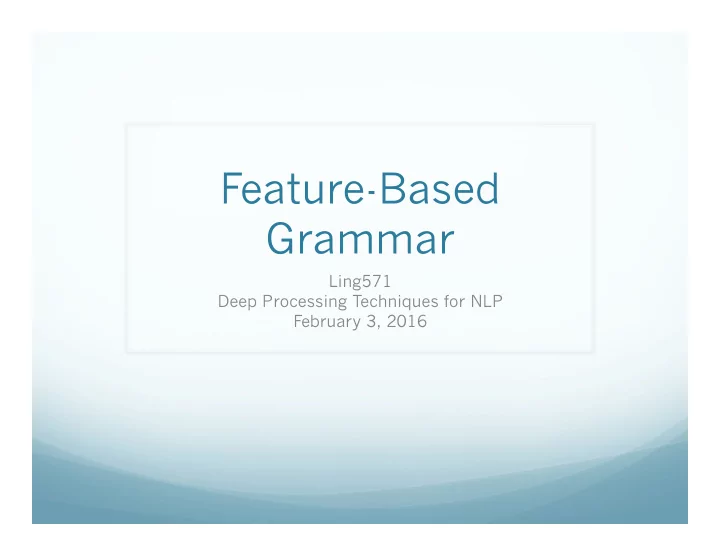

Feature-Based Grammar Ling571 Deep Processing Techniques for NLP February 3, 2016
Features in CFGs: Agreement Goal: Support agreement of NP/VP , Det Nominal Approach: Augment CFG rules with features Employ head features Each phrase: VP , NP has head Head: child that provides features to phrase Associates grammatical role with word VP – V; NP – Nom, etc
Simple Feature Grammars S -> NP[NUM=?n] VP[NUM=?n] NP[NUM=?n] -> N[NUM=?n] NP[NUM=?n] -> PropN[NUM=?n] NP[NUM=?n] -> Det[NUM=?n] N[NUM=?n] Det[NUM=sg] -> 'this' | 'every’ Det[NUM=pl] -> 'these' | 'all’ N[NUM=sg] -> 'dog' | 'girl' | 'car' | 'child’ N[NUM=pl] -> 'dogs' | 'girls' | 'cars' | 'children'
Parsing with Features >>> cp = load_parser('grammars/book_grammars/ feat0.fcfg’) >>> for tree in cp.parse(tokens): ... print(tree) (S[] (NP[NUM='sg'] (PropN[NUM='sg'] Kim)) (VP[NUM='sg', TENSE='pres'] (TV[NUM='sg', TENSE='pres'] likes) (NP[NUM='pl'] (N[NUM='pl'] children))))
Feature Applications Subcategorization: Verb-Argument constraints Number, type, characteristics of args (e.g. animate) Also adjectives, nouns Long distance dependencies E.g. filler-gap relations in wh-questions, rel
Morphosyntactic Features Grammatical feature that influences morphological or syntactic behavior English: Number: Dog, dogs Person: Am; are; is Case: I – me; he – him; etc Countability:
Semantic Features Grammatical features that influence semantic (meaning) behavior of associated units E.g.: ?The rocks slept. Many proposed: Animacy: +/- Natural gender: masculine, feminine, neuter Human: +/- Adult: +/- Liquid: +/-
Aspect (J&M 17.4.2) The climber hiked for six hours. The climber hiked on Saturday. The climber reached the summit on Saturday. *The climber reached the summit for six hours. Contrast: Achievement (in an instant) vs activity (for a time)
Unification and the Earley Parser Employ constraints to restrict addition to chart Actually pretty straightforward Augment rules with feature structure Augment state (chart entries) with DAG Prediction adds DAG from rule Completion applies unification (on copies) Adds entry only if current DAG is NOT subsumed
Summary Features Enable compact representation of grammatical constraints Capture basic linguistic patterns Unification Creates and maintains consistency over features Integration with parsing allows filtering of ill- formed analyses
HW #5 Ling 571 Deep Techniques for NLP February 3, 2016
Feature-based Parsing Goals: Explore the role of features in implementing linguistic constraints. Identify some of the challenges in building compact constraints to define a precise grammar. Gain some further familiarity with NLTK. Apply feature-based grammars to perform grammar checking. Individual work
Task Create grammar rules with features Produce a single parse for grammatical sentences Single parse per line Reject ungrammatical sentences Print blank line Homework includes sentences and “key”
Feature Grammar in NLTK NLTK supports feature-based grammars, including ways of associating features with CFG rules readers for feature grammars .fcfg files parsers Nltk.parse.FeatureEarleyChartParser Nice discussion, examples in NLTK book CH. 9 (Ch. 8, ed1) NOTE: HPSG-style comps list <NP ,PP ,..> NOT built into NLTK Can be approximated with pseudo-list: e.g. [FIRST=?a, REST=?b] For Extra-credit
Feature Structures >>> fs1 = nltk.FeatStruct(“[NUM=‘pl’]”) >>> print fs1 [NUM=‘pl’] >>> print fs1[‘NUM’] pl More complex structure >>> fs2 = nltk.FeatStruct(“[POS=‘N’, AGR=[NUM=‘pl’,PER=3]]”)
Reentrant Feature Structures First instance Parenthesized integer: (1) Subsequent instances: ‘Pointer’: -> (1) >>> print(nltk.FeatStruct("[A='a', B=(1)[C='c'], D->(1)]”)) [ A = ‘a’ ] [ B = (1) [ C = ‘c’]] [ D -> (1) ]
Augmenting Grammars Attach feature information to non-terminals, on N[AGR=[NUM='pl']] -> 'students’ N[AGR=[NUM=’sg']] -> 'student’ So far, all values are literal or reentrant Variables allow generalization: ?a Allows underspecification, e.g. Det[GEN=?a] NP[AGR=?a] -> Det[AGR=?a] N[AGR=?a]
Mechanics >>> fs3 = nltk.FeatStruct(NUM=‘pl’,PER=3) >>> fs4 = nltk.FeatStruct(NUM=‘pl’) >>> print fs4.unify(fs3) [NUM = ‘pl’] [PER = 3 ]
Recommend
More recommend